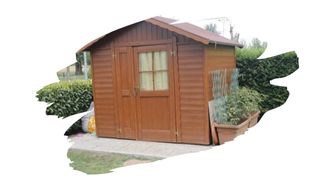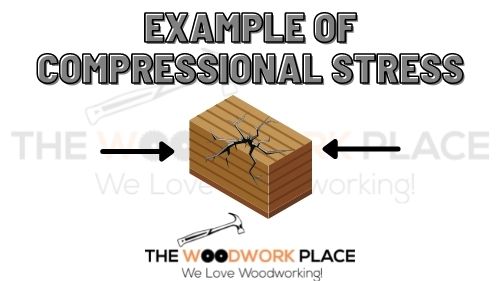Your shed floor needs to be made from a material that can hold the weight of heavy tools and boxes. It also needs to be water-resistant enough to shrug off moisture and humidity.
And it needs to be durable enough to do both for years on end.
So, when you compare Plywood vs OSB, which one of these two manufactured woods is truly up to the job?
Well, in this post, you will discover whether plywood or OSB is stronger. You will also learn which material is much better suited for your shed floor…

This post may contain affiliate links to products that we receive a commission for (at no additional cost to you). Learn more here.
Which Material Is Stronger…Plywood Or OSB?
Well, there are three general ways that we can compare the strength of these two manufactured woods. We can look at their shear strength, their tensile strength, and their compressional strength.
Now, when it comes to wall sheathing and attic flooring, the shear strength of a material is what matters most.
Related Post: Why You Should Use OSB (Not Plywood) For Your Attic Floor
Shear strength measures how well material can hold up against shear stress (i.e. slippage).
But, when it comes to selecting material for a ground floor, it’s the compressional strength of it that matters most. Why? Well, because compressional strength measures how well wood can hold up before it collapses under compressional stress.

Now, there’s a good reason why we need to clarify these two different types of strength.
You see, OSB is much stronger than plywood when it comes to shear strength. In fact, OSB has double the shear strength of plywood. But, when it comes to compressional strength, plywood has twice the strength of OSB.
In fact, plywood can handle up to 5000 lbs of pressure per square inch. While OSB, in comparison, can handle up to 2500 lbs of pressure per square inch.
And this is one of the main reasons why plywood is better for your shed floor.
But Why Does That Make Plywood The Better Option?
Well, a shed floor is going to be put under a fair bit of compressional stress as you walk on it. And it also needs to hold up underneath the weight of all your stored tools and equipment.
In comparison, OSB is fine for an attic floor, since it isn’t going to be walked upon often (if at all). And it certainly isn’t the kind of floorspace where you will be storing heavy cabinets or toolboxes.
But, more importantly, thanks to it’s compressional strength, plywood is less likely to sag than OSB. This makes plywood surprisingly rigid.
And plywoods rigidity is a big advantage when it comes down to selecting a shed floors material.
Related Post: What Is The Best Type Of Plywood For A Van Floor? (Solved!)
And What Particular Kind Of Plywood Should You Use For A Shed Floor?
You will need to use exterior graded plywood that has also been pressure treated.
Exterior graded plywood will have had its plies glued together using a water-resistant adhesive. This makes it less likely to delaminate if moisture or humidity gets onto it.
Delamination, (as it relates to plywood), is when plywood’s glue starts to lose its adhesion. When this happens, the glue falls apart — along with those plywood sheets. And delamination can happen if a lot of water saturates plywood.
However, the water-resistant glues in exterior graded plywood, are less likely to have this issue.
Now, exterior graded plywood will have an ‘X’ in it’s grade. This indicates that an exterior graded glue has been used to bind that sheet.
For example, BCX plywood is an exterior graded plywood. That’s because BCX plywood is made by gluing a B-grade sheet to a C-grade sheet, using e(X)terior-graded glue.
Related Post: A Quick Beginners Guide To BCX Vs RTD Plywood
And What Do You Mean By Pressure Treated Plywood?
Pressure treated plywood has been infused with rot-resisting wood preservatives. These chemical preservatives fight off the bacteria responsible for wood rot — acting very much like a fungicide.
So, if your shed floor happens to become damp — and takes a while to dry out — pressure treated plywood is much less likely to rot and decay.
In fact, any plywood that’ll have prolonged ground contact should be pressure treated.
You can tell plywood has been pressure treated by checking for a stamp marking it as such. In the US, UK, and Canada, pressure treated plywood will have been stamped with PT (Pressure Treated) or GC (Ground Contact).
To Wrap Up, Here Are The 3 Key Takeaways From This Post…
- 1). OSB has twice the shear strength of plywood. But, plywood has twice the compressional strength of OSB. Therefore, plywood’s compressional strength advantage makes it better suited for becoming a shed floor.
- 2). Plywood is less likely to sag than OSB, as it is a more rigid material.
- 3). Make sure you use exterior-graded plywood, (that’s also been pressure treated), for your shed floor. This type of specially-treated plywood is less likely to rot and decay.
References:
Choosing Between Oriented Strandboard And Plywood | University of Massachusetts Amherst
Strength Properties of Wood for Practical Applications | Oklahoma State University (okstate.edu)



